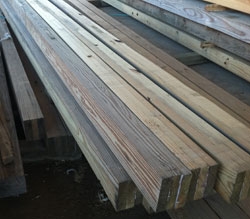NDS Size Factor (Cf) for Lumber
Continuing explaining terms used in a decade old article of mine (https://www.hansenpolebuildings.com/2014/08/lumber-bending/) is Cf (size factor, also known as width adjustment factor).
NDS (National Design Standards)design values for SYP (Southern Yellow Pine) are specified by size due to actual, physical in grade testing, whereas other lumber species’ design values have a base value adjusted by width of member.
Prior to 1957 no size adjustment equations for deep bending members were given in the NDS, only other publications were referenced based upon tests of bending members up to 12 inches deep. From 1957 to 1968 specifications included an adjustment factor for deep bending members.
 Back in the day, most engineers specified a minimum lumber grade on their plans (such as Douglas Fir #1 or better) and didn’t go much further. Then someone mentioned glu-laminated timber industry was using a volume factor to modify a member’s section modulus (S or Sm) indirectly influencing stress carrying capacities. It was wondered if sawn lumber should have a similar factor, resulting in actual in grade physical testing.
Back in the day, most engineers specified a minimum lumber grade on their plans (such as Douglas Fir #1 or better) and didn’t go much further. Then someone mentioned glu-laminated timber industry was using a volume factor to modify a member’s section modulus (S or Sm) indirectly influencing stress carrying capacities. It was wondered if sawn lumber should have a similar factor, resulting in actual in grade physical testing.
It was found smaller members failed (broke) at higher stress levels than deeper members. Applying statistical analysis methods a percentage factor (Cf) was to be applied to 2x and 4x members between four and 16 inch depths.
The intent was for engineers to be able to account for this stress skew in their calculations, without having to specify on their plans grade of every size member being used.
For two inch thick lumber, visually graded as #3, #2, #1, #1 and better or Select Structural. Fb (fiberstress in bending) value was assigned a Cf of 1.0 (or no adjustment). 2×2 through 2×4 Cf = 1.5, 2×5 = 1.4, 2×6 = 1.3, 2×8 = 1.2, 2×10 = 1.1 and 2×14 and wider = 0.9. These values, as well as adjustment factors for Ft (fiberstress in tension) and Fc (fibrstress in compression) can be found in the NDS.






